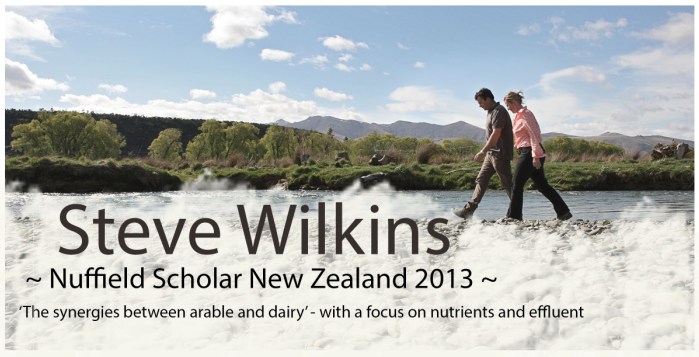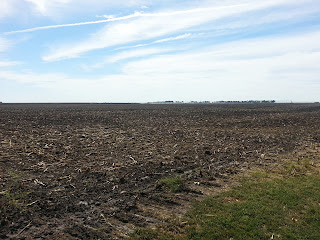Demand for corn from overseas as well as a strong domestic market in the form of ethanol production, has seen the price rallying to new heights in recent times. Prices up over $ 8.00 a bu being reached and are now sitting at around $ 4.60 - $ 5.00 a bu.
The need for the dairy units to have land to spread the effluent has led to new opportunities for Ruth Farms and others in the area to receive these nutrients back on to the farm.
This happens in two ways:
- firstly in liquid form through a network of some 100 km of underground 250mm PVC piping to centre pivot irrigators.
- Secondly by the injection of slurry from the settling ponds which are cleaned out twice a year.
The PVC piping is laid at the dairy farms expense and the application is also carried out by dairy staff. The cost of the slurry injection is typically $300 per ha and this cost is shared 50/50. Injecting is done at a rate of 50 000 litres per ha or 5 mm.
This provides the ability to grow a 220bu corn crop without the need for artificial fertiliser. The system works very well for both parties involved.
However, because the dairy is fully indoor and the cows are fed a TMR, the system in it's present form would fit only a small number of farms in New Zealand. But with this in mind the concept is very sound and with some adaption is an option worthy of consideration.
Production is 18 500lb milk per cow - a little below the State average of 21 300lb. This is very good when considering nearly all the dairy herds in Indiana are in a high cost TMR system. Dry seasons have meant that more suppliments are required than ideal.
- Farm is 220 in total and is husband and wife labour - with help from their daughter, who is married and to a hay contractor and lives in the local town.
- Forage is grown on farm and grain (corn, cotton seed, distillers grain hulls) are bought in from an upstate co-op, where there is a bigger area of dairy and more options.
- Most of the local area is in beans and corn - 40% of US corn goes to ethanol production.
- Milk is supplied to a co op about an hour away.
- Hay is made in may from excess grass and corn is produced annually.
- There is no artificial fertiliser used on the farm.
Because the farm carries less than 300 cows and has land attached the is no environmental regulation to adhere to. The effluent is injected into fields where possible and is spread on top discreetly when necessary. These operations are carried out by a contractor.
A very hands on business for the husband and wife team. When Charlie talks about the fact that the milking parlour needs replaced, I can't help but think this would be the ideal situation to install a robotic milking system. This would not only overcome the shed replacement but also free up some time for the two of them to enjoy some free time...
N is typically applied in liquid form and is stored on farm in a bunded 30 000 l tank. This is being seen as a viable alternative to solid or adhydrous N that is susceptible to leaching and volatilisation. Liquid N, on the other hand can be taken straight in by plant.
Corn yeilds are typically 200 220 bu.
Wheat is harvested with a stripper header, this allows the crop to be harvested earlier and increases the window to get the late beans in 10 - 14 days earlier, which can mean the difference between getting a crop or not.
Tony is a county commissioner and was the President of the American Soyabean Association. He tells me the EPA is introducing legislation next year that will limit the amount of fertiliser that can be applied based on soil types?
Tony is trying to get people from the local university to develop a program that will give the exact amount of grain produced from each of the feriliser components needed to grow a crop. This would then give a value of those nutrients and thereby give a template for him to use in setting price for the fertiliser. As opposed to the current system where the fert company takes as much profit as it thinks the farmer can afford.
Philip Eby
Product Marketing Manager
Crop Preparation Products
Plant Manager
Round balers
Small square balers
Mowers, both trailed and attached
Manure spreaders
Cyicle mowers for China mostly.
Product evaluation is also done here and sees many of the units undergoing feild simulated testing. A bump track had a Case 8230 combine being driven across it with auger folded out and being put through its paces over the period of a days work. The driver also looked like he had done a days work when he emerged from the cab!
Several climate controlled booths are used to simulate various temperatures and fluctuations, particularly important with the tier 4 emmission standards. While the engine manufacturers do their own testing, the environment is much different for an engine on a combine or forage harvester with many parisitic features attached to them.
Spray boom frames and combine cleaning shoes are also put through various stress tests on jigs that replicate thousands of hours of use.
Hydraulic systems are attached to the equipment to simulate loadings equivalent to field conditions.
The BR series baler is undergoing a model change and this will go into production for next season.
The machining building produces many of the components for not only the equipment built in PA but also for the windrowers and equipment produced at other plants throughout the US.
Thanks to John and Phil for their time and providing a detailed tour.



























